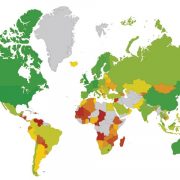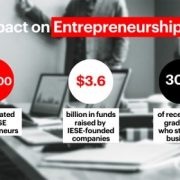Academic Year Kicks Off with Record Number of MBA Students, New Covid-19 Measures
- IESE´s MBA Class of 2023 is the largest in the school´s history with nearly 400 students and a new sixth section. They join new cohorts of IESE´s Master in Management (MiM) and Executive MBA programs beginning classes in Barcelona, Madrid, and Munich.
- IESE is one of the only top schools to have remained open for in-person classes since June 2020, thanks to putting in place rigorous health and safety protocols. This academic year, safety measures have been updated to include new protocols on vaccination and testing.
This week around 1000 students begin in-person courses of the MBA, Master in Management (MiM), and Executive MBA programs at IESE Business School´s campuses in Barcelona, Madrid and Munich. IESE´s rigorous set of health and safety measures, which enabled it to be among the first business schools to return to face-to-face classes back in June 2020, have been updated to include new protocols on vaccination and testing. The updated protocols ensure a safe and productive educational environment for all.
Despite the ongoing disruption caused by the Covid-19 pandemic, continued strong demand from high quality applicants for IESE´s masters programs means that the school was also able to open a sixth section of its full-time MBA program for the first time this year. The incoming MBA class of 2023 is the largest in the school´s history with 387 students, up from 355 last year. More than eighty percent of the class are international, with students hailing from 59 different nationalities.
IESE´s full-time MBA students take classes at IESE´s campus in Barcelona, and study the program in English over 15 or 19 months. The average age of the class is 29.
The new students of IESE´s Master in Management (MiM) class of 2022 also recently began classes at IESE´s campus in Madrid. The class counts on 77 students from 27 different nationalities. Aimed at recent graduates with minimal or no work experience, the average age of the class is 23.
Launched three years ago and taught over 11 months, the MiM is a full-time program in English from the Spanish capital. It provides an immersive experience for participants, enabling them to acquire the best business tools to kick-start their management career.
Meanwhile, the new edition of the Executive MBA program in Munich has also started. IESE´s campus in Germany begins its third class of the executive MBA with 62 new participants from 22 different nationalities. The average age of the class is 35.
Ensuring a safe, innovative campus
From the start of the Covid-19 pandemic, IESE worked quickly to adapt its classrooms and put in place a comprehensive set of health and safety measures. These measures enabled IESE to successfully return to face-to-face classes over a year ago.
IESE´s extensive efforts to safeguard its campuses include restricted campus access and temperature controls, mandatory mask use in all common spaces combined with a high tech air-renewal and renovation system. As the pandemic has evolved, these safety measures have been further updated for the 2021-2022 academic year to include new protocols on vaccination and testing.
IESE is strongly recommending all participants and staff are fully vaccinated and provide proof of that with an official certificate. Those who are not will need to provide weekly proof of a negative PCR, serological or antigen test in order to access campus.
Participants who are unable to attend in-person classes will also continue to be able to connect to classes remotely.
More on IESE´s health protocols.










